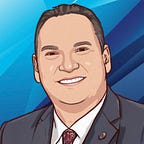Out Of 126 Healthcare White Papers We Analyzed, One Stood Out. Part 2
DAO for Doctors can solve the lack of community crisis in Healthcare
In part 1 we discussed that Healthcare is currently a non-sustainable business ecosystem because it lacks a community that shares a common sense of purpose and that the first step to create a community is to design incentives based on distributed trust.
In part 2 we will discuss how to build a governance system within a decentralized business organization.
First, apply systems thinking
It is necessary to apply a systems thinking approach that can map the interconnectedness and emergent properties of the healthcare system, identify causality within it and locate the positive/negative feedback mechanisms that maintain the current status quo.
Second, design a governance system
Such a design would include a governance with monetary and non-monetary incentives that encourage coordination and discourage predatory practices, while providing a common mission, taxonomy and sense of purpose.
(for an excellent review on governance please read Fred Ehrsam here).
The best design for good Governance (from Daniel Larimer here) includes:
- Performance orientation
- Openness, transparency, integrity
- Effective collaboration
Because governance is a coordination effort driven by different stakeholders with different (and sometimes competing) agendas there are different models of governance:
- Autonomous Governance which requires little coordination and ensures only the maintenance of a pre-determined protocol, code or agreement(s).
- Governance Capture where governance “captures” previous corporate, regional or State rules maintaining sovereignty, privacy and data protection (the most applicable to healthcare).
- Public/Private Governance via international law, driven by private people, corporations and NGOs (perhaps appropriate for WHO, ICRC, MSF, MDM).
(for a full review read Vlad Zamfir post here).
To ensure successful implementation of a governing protocol, describing minimal community etiquette is necessary. These behaviors should define civility (the Do’s and Don’t) and the expectation of an active and direct involvement of members in the wellbeing of the community (citizenry).
(I wrote about direct democracy instruments here).
Third, Implement Governance Within A Dao For Doctors
Why a Distributed Autonomous Organization (DAO)?
DAO is a business or organization whose decisions are made electronically by a written code through the vote of its members (Universa). In essence it is a system that defines which actions the organization will take in specific scenarios. These rules can be anything from dividend payouts at a certain event to how members are encouraged to interact with each other.
The idea of a DAO is not just to overcome human fallibility in business (think greed, stupidity, laziness) but to avoid toxic behavior (the tragedy of the commons) by connecting people to a common cause that everyone owns.
Humanitarian Physicians Empowerment Community- DAO For Doctors
Humanitarian Physician Empowerment Community (HPEC) is a DAO for Doctors that gives every physician a self-sovereign digital identity which allows them to move freely throughout the healthcare system (similar to Hashed Health, InvitaHealth, Truu and Blockcerts). However it also creates a decentralized community that allows physicians to convene, discuss and collaborate with other fellow colleagues on practices, science and policy through the incentive of fractional ownership of the platform.
(Disclosure: I advise HPEC on a voluntary basis)
Finally, consider decentralized organizations other than DAO
There are decentralized models other than DAO, that may be suitable when designing distributed trust (and power) in healthcare. These include:
- Decentralized Autonomous Cooperatives (DAC) which are a collaboration of multiple DAOs, that may generate tokens through a DAICO.
- Continuous Organizations (CO) that are organizations that set themselves in continuous fundraising mode, aligning stakeholders’ interests to their financial success through a Decentralized Autonomous Trust (DAT).
- Collaborative Network Economies (CONE) where large companies create autonomous decentralized company-like teams (below).
To Sum It Up:
- Healthcare is currently a non-sustainable business ecosystem because it lacks a community that shares a common sense of purpose.
- The first step to create a community is to design incentives based on distributed trust, that encourage collaboration and discourage predatory practices.
- The next step is to design a governance system that increases choice, diversity and competition while encouraging civility and active participation (citizenry) through fractional ownership.
- Professional DAOs (like HPEC), DACs, COs or CONEs can all serve as structural decentralized models that can transform different elements in healthcare into a more sustainable, resilient business ecosystem.
To start a DAO check out these applications like AragonOS or DaoStack and do not forget to join our upcoming Governance & Consensus Meetup on January 9th with DAOStack.
If you liked what you read, go ahead and “Clap” below so others will see it too (up to 50 claps allowed!)
